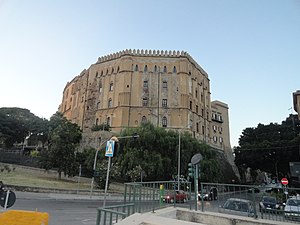Imperial Circle of Slethar
This article is incomplete because it is pending further input from participants, or it is a work-in-progress by one author. Please comment on this article's talk page to share your input, comments and questions. Note: To contribute to this article, you may need to seek help from the author(s) of this page. |
Imperial Circle of Slethar Σλεθαρη Ρεξιονη Ϡικλος | |
|---|---|
 Label used by the Imperial Circle | |
| Leadership | |
| Structure | |
| Seats | Varying, currently ~32[a] |
 | |
Political groups | |
| Elections | |
| None; appointment by the Emperor | |
| Meeting place | |
 | |
| Lōpsuan Palace, Lōpsus | |
| Footnotes | |
The Imperial Circle of Slethar (Sletharine: Σλεθαρη Ρεξιονη Ϡικλος) is the decisionmaking body of the Empire of Slethar. It is officially a body functioning as a respresentation of a imperial court, but is in effect the dictating legislative and partially also executive body, to which the Thringat and government are subservient.
History
TBA
Membership
Imperial Circle consists of mostly imperial family members, high-ranked royalists and other feudals selected by the Emperor to help him consult and decide on the direction of the country. Currently, about 32 members are attending the meetings of the Imperial Circle. Historically (since 2006 reestablishment of the monarchy in Slethar), the number of members fluctuated between 18 at the lowest and 43 at the highest.
Imperial Circle's membership is based on the decision and ruling of the Emperor and as such is not limited by any other regulation. Members can be any gender, religion, sexuality, nationality or estate. Currently, however, due to the nature of system, the Circle is predominantly male, Orthodox and between 40 and 65 years of age. Major exception of this rule is the current successor to the throne, the Crown Prince Aldabert, who is only 19.
<graph>{"legends":[],"scales":[{"type":"linear","name":"x","domain":{"data":"chart","field":"x"},"zero":false,"range":"width","nice":true},{"type":"linear","name":"y","domain":{"data":"chart","field":"y"},"zero":false,"range":"height","nice":true},{"domain":{"data":"chart","field":"series"},"type":"ordinal","name":"color","range":["black"]}],"version":2,"marks":[{"type":"line","properties":{"hover":{"stroke":{"value":"red"}},"update":{"stroke":{"scale":"color","field":"series"}},"enter":{"y":{"scale":"y","field":"y"},"x":{"scale":"x","field":"x"},"stroke":{"scale":"color","field":"series"},"interpolate":{"value":""},"strokeWidth":{"value":2.5}}},"from":{"data":"chart"}}],"height":250,"axes":[{"type":"x","title":"Year (Anno Domini)","scale":"x","format":"d","properties":{"title":{"fill":{"value":"#54595d"}},"grid":{"stroke":{"value":"#54595d"}},"ticks":{"stroke":{"value":"#54595d"}},"axis":{"strokeWidth":{"value":2},"stroke":{"value":"#54595d"}},"labels":{"fill":{"value":"#54595d"}}},"grid":false},{"type":"y","title":"Number of members","scale":"y","format":"d","properties":{"title":{"fill":{"value":"#54595d"}},"grid":{"stroke":{"value":"#54595d"}},"ticks":{"stroke":{"value":"#54595d"}},"axis":{"strokeWidth":{"value":2},"stroke":{"value":"#54595d"}},"labels":{"fill":{"value":"#54595d"}}},"grid":false}],"data":[{"format":{"parse":{"y":"integer","x":"integer"},"type":"json"},"name":"chart","values":[{"y":23,"series":"y1","x":2006},{"y":18,"series":"y1","x":2007},{"y":25,"series":"y1","x":2008},{"y":29,"series":"y1","x":2009},{"y":35,"series":"y1","x":2010},{"y":31,"series":"y1","x":2011},{"y":38,"series":"y1","x":2012},{"y":41,"series":"y1","x":2013},{"y":32,"series":"y1","x":2014},{"y":43,"series":"y1","x":2015},{"y":22,"series":"y1","x":2016},{"y":19,"series":"y1","x":2017},{"y":25,"series":"y1","x":2018},{"y":38,"series":"y1","x":2019},{"y":29,"series":"y1","x":2020},{"y":27,"series":"y1","x":2021},{"y":28,"series":"y1","x":2022},{"y":32,"series":"y1","x":2023}]}],"width":750}</graph>
Legislative process
TBA